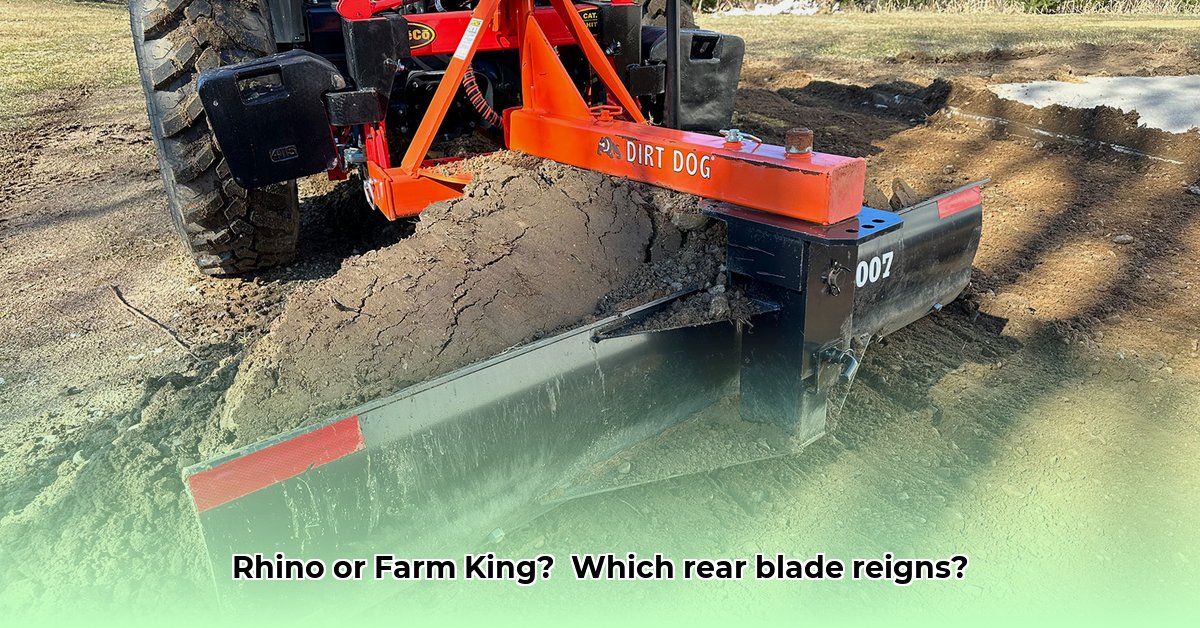
Choosing the right rear tractor blade is crucial for efficient and effective farm operations. This comparative review analyzes Rhino and Farm King (Allied) rear blades, highlighting key differences to help you make an informed decision. We'll examine construction, adjustability, cutting edge design, hitch systems, and provide a step-by-step guide to choosing the best blade for your needs. This guide focuses on matching blade capabilities to your tractor's horsepower, a critical factor often overlooked. For more detailed information, see this helpful guide.
Construction: Durability Under Pressure
Both Rhino and Farm King emphasize robust construction, but the specifics differ. Rhino, particularly in their larger 2500 and 3500 series, boasts solid steel kingpins and moldboards, suggesting superior durability for heavy-duty applications. Farm King's Allied series advertises "more steel," but lacks precise details on steel grades and thicknesses. This lack of transparency makes a direct material comparison difficult. Without precise metallurgical data, determining which brand offers superior long-term durability requires further investigation. How important is this to you? Do you need a blade built to withstand years of extreme use, or will a more economical option suffice?
Adjustability: Precision and Ease of Use
Adjustability is a key differentiator. Rhino's larger models feature complete hydraulic adjustment, providing precise control over swing, moldboard angle, and tilt. This is invaluable for grading and shaping. Farm King's Allied series offers a mix of manual and hydraulic adjustments depending on the model. Smaller models (30 and 45 series) are typically manual, while larger (100 and 155 series) models offer hydraulic adjustment, but the range of adjustment, especially offset, may be less extensive than Rhino's. "Hydraulic adjustment offers unparalleled precision, but manual adjustments are suitable for less demanding tasks," explains Dr. Emily Carter, Agricultural Engineering Professor at Purdue University. Does your work require pinpoint accuracy, or is approximate adjustment acceptable?
Cutting Edge Design and Lifespan: Maximizing Efficiency
Rhino's design extends the cutting edge beyond the moldboard, potentially reducing wear. Farm King uses high-carbon steel, a promising feature, but lacks detailed design specifics. Without comparable data on cutting edge design and materials, it's difficult to predict which blade will provide longer service life. This highlights a critical need for manufacturers to provide more detailed specifications. What is your expected annual usage, and how long do you intend to use your blade?
Hitching Up: Seamless Integration
Both brands offer quick-hitch compatibility, a significant time saver. However, neither consistently specifies which hitch categories (I, II, or III) their models support. This vital information is crucial for compatibility. Always verify hitch compatibility before purchasing.
Choosing Your Perfect Blade: A Comparative Table
The following table summarizes key features for easy comparison:
| Feature | Rhino | Farm King Allied Series | Considerations |
|---|---|---|---|
| Horsepower Range | Higher horsepower tractors | Wider range, including lower horsepower | Match blade to your tractor's capabilities. |
| Adjustability | Primarily hydraulic, extensive range | Mix of manual and hydraulic, varies by model | Hydraulic offers superior precision; manual suffices for simpler tasks. |
| Construction | Heavy-duty steel, robust design | "More steel" claimed, details unspecified | Durability is key; investigate specific material properties. |
| Cutting Edge | Extended design, potentially longer life | High-carbon steel, design details lacking | Consider task intensity to estimate lifespan. |
| Quick Hitch | Yes, on larger models | Yes, across all models | Verify hitch type (I, II, or III) for compatibility. |
Making the Right Choice: A Step-by-Step Guide
- Assess your needs: Define your tasks (land clearing, snow removal, grading). This determines required blade size and strength.
- Check tractor specs: Consult your owner's manual for PTO horsepower and recommended implement weights.
- Set your budget: Prices vary considerably.
- Compare features: Carefully review the pros and cons of each brand, focusing on durability, ease of use, and warranty.
- Contact local dealers: Obtain quotes and inquire about parts availability and service.
- Make your selection: Choose the blade that best suits your needs, budget, and tractor capabilities.
Matching Blade to Tractor Horsepower: Avoiding Overloading
Matching blade size to tractor horsepower is critical. Overloading your tractor leads to reduced efficiency and potential damage. Consult your tractor's manual for recommended implement weights and PTO horsepower. Both Allied and Rhino provide a range of sizes; choose carefully. A properly matched blade maximizes your tractor's efficiency and prolongs its lifespan.
Comparing Rhino and Allied Blades: Feature-by-Feature Detail
Both Rhino and Allied are reputable brands, but differ in key areas.
Rhino blades are known for robust construction and heavy-duty materials, ideal for demanding applications. Allied blades might offer a more budget-friendly choice while maintaining good quality, suitable for a wider range of users.
| Feature | Rhino | Allied | Considerations |
|---|---|---|---|
| Construction | Typically heavy-duty steel | Robust steel construction | Heavier is better for tough jobs; lighter options are more maneuverable. |
| Blade Adjustments | Usually hydraulic, comprehensive | Often hydraulic, but manual options are available. | Hydraulic offers superior precision; manual is simpler, less precise. |
| Warranty | Check manufacturer's website | Check manufacturer's website | Warranty length and coverage are crucial considerations. |
| Price | Generally higher | Generally lower | Weigh initial cost against long-term durability and maintenance. |
| Parts Availability | Check your local dealer | Check your local dealer | Easy access to spare parts is critical for minimizing downtime. |
Remember to always consult with your local dealer for the most up-to-date pricing and availability.